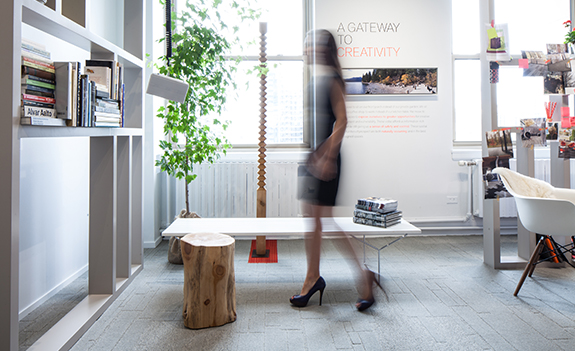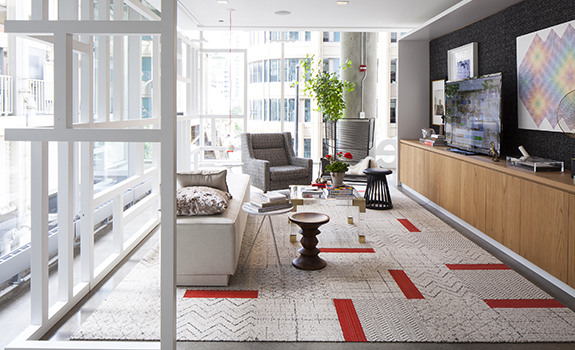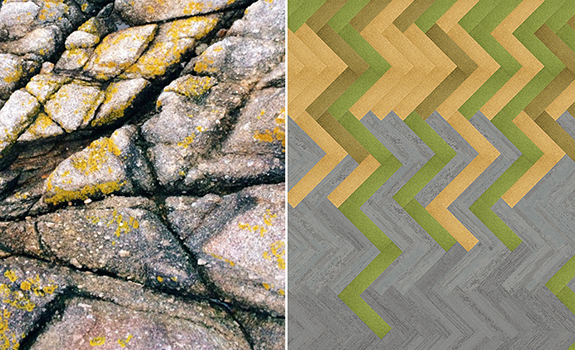Beauty may be in the eye of the beholder. But when we see beauty—whether in a glorious sunset, a majestic mountain, an inspired building, or a fellow human being—we know it. Visual beauty is tangible.
When it comes to thinking, though, how do we know when our ideas are beautiful? Interface has been dwelling on this question a lot lately—particularly with respect to how it impacts a sense of well-being in sustainably designed spaces. They also recognize that visionaries both past and present—from the legendary architect, R. Buckminster Fuller, to the brilliant founder of Apple, Steve Jobs, to the CEO of the International Living Future Institute, Jason McLennan, one of the most influential individuals in the green building movement—have pondered this question, too, and have applied their theories to solve some of the world’s most pressing problems with transformational results.

What is “beautiful thinking?” The people at Interface have been dwelling on this question a lot lately—particularly with respect to how it impacts a sense of well-being in sustainably designed spaces.
To give shape to the idea of “Beautiful Thinking,” we asked some thought leaders: “What does ‘Beautiful Thinking’ mean to you?” Their responses yielded some interesting common threads. Read on for seven of the most compelling of them.
What does beautiful thinking mean?
Nature and beauty are inseparable—and humans are part of it
“Research has shown that humans have an innate love of and need for nature,” says Jason McLennan, CEO of the International Living Future Institute and the founder and creator of the Living Building Challenge, the world’s most progressive and stringent green building program. “Our ‘biophilia,’ according to studies, is hard-wired,” he says. “We naturally seek out environments where nature is present and react negatively to environments that are sterile, cold, and without any connection to nature.”
Science and beauty are innately interconnected
“Buckminster Fuller would take on any challenge with a systemic approach to problem-solving,” says Elizabeth Thompson, executive director of the Buckminster Fuller Institute. “For him, there was no greater source of ‘Beautiful Thinking’ than in the patterns of nature, and in how efficient Nature is with her use of materials. He was sometimes referred to as a ‘radical utopian,’ who relied on fundamental truths of science and research to uncover truths about how the universe is structured to get to the root of things, and it’s been said that if you’re at the root you’re touching the spiritual,” she adds. “Fuller himself once said, ‘When I am working on a problem I never think about beauty, I think only how to solve the problem. But when I have finished, if the solution is not beautiful, I know it is wrong.’”
In other words, beauty may not be the goal of “Beautiful Thinking,” but invariably it emerges as a result of it.

“When I am working on a problem I never think about beauty, I think only how to solve the problem. But when I have finished, if the solution is not beautiful, I know it is wrong.” -Buckminster Fuller
Nature has much to teach us about creating great human habitat
“In the same way that nature creates conditions conducive to life,” says Lindsay James, a certified biomimicry professional, “businesses can think of ways to create conditions that are conducive to life, both for the larger ecological system and for the well-being of the people in the company. One step we can take is to create spaces for our people that promote health and wellness. One of the pitfalls we seem to be running into is to define health in buildings purely in terms of the absence of potentially hazardous chemicals. This has the potential to allow fear of chemicals to overshadow other ways that we can make buildings ‘life-friendly.’
The increasingly robust research on biophilic design shows us how better designed buildings produce some of the proven physiological and psychological benefits of spending time in nature. Our current value-engineering practices don’t take this kind of benefit into account,” she explains. “But when companies see health-care costs of employees declining in biophilically-designed spaces, then there’s an economic argument for good design.”
Variety is the spice of stimulating spaces
“We should strive to create places where we fit and where we belong; places with both prospect and refuge that appeal to us on a deep psychological level,” says McLennan. “There is additional emerging evidence indicating that we also crave beauty in the form of order, proportion, texture, color, and localized symmetry. I refer to this instinct as ‘’ The pleasure we experience when we witness symmetry in nature—as in sacred geometry or the elegant layout of the human face— demonstrates this powerful force.”
Holistic environments inspire creativity and innovation
Spaces derived from “Beautiful Thinking” can have a ripple effect on people and the broader systems they’re a part of. “Interface is a carpet tile company that mimics nature in its manufacturing process and continues to develop restorative circular economy strategies to drive all industries to a new level of success in business,” says George Bandy, Mohawk Group’s Vice President of Sustainability.

Spaces that allow people to be connected to nature while providing them with the freedom to push their professional and productivity limits creates a contagious spirit of success.
“This model considers financial profitability on the same level as environmental and social success on the balance sheet. It also involves the type of mental engagement that delivers a comprehensive positive impact on ‘tomorrow’s child.’ A space that allows people to be connected to nature while providing them with the freedom to push their professional and productivity limits creates a contagious spirit of environmental, social and economic success.”
What we do to the planet, we do to ourselves
“Biophilia implies humility on ourpart in and respect for the four billion years of life’s existence,” says Canadian environmental activist, Dr. David Suzuki. “We are a very clever animal but now our clever inventions are so powerful, that they can have immense consequences and we don’t know enough to anticipate them,” he adds. “When DDT was found to be insecticidal, we didn’t know about biomagnification until eagles began to disappear. When atomic bombs were dropped on Japan, we didn’t know about radioactive When CFCs began to be used in spray cans, no one knew about their impact on ozone. Over and over, our clever inventions have unanticipated deleterious consequences. Biomimicry asks nature for solutions to problems and nature has had billions of years and a multitude of ways to resolve them. Chances are nature’s solutions will be far more benign than ours.”
We can improve the quality of our lives by mimicking nature
“When we think about biophilic design that’s evocative of the patterns, forms, and textures in nature, it isn’t limited to literally copying or using natural features in our spaces. We can strive to mimic the type of sensory stimulation our brains receive when we are in nature, including things as simple as flooring with variable hardness and texture, just as you would find underfoot in any forest,” James suggests. “Our brains have evolved over the past 200,000 years in natural settings, so if we want our spaces to bring out the best in people, Nature is where we should look for design inspiration.”

One response to “What Does Beautiful Thinking Mean?”
A brilliantly wrtten article –
Thanks for sharing it with us.
Maria Evangelou